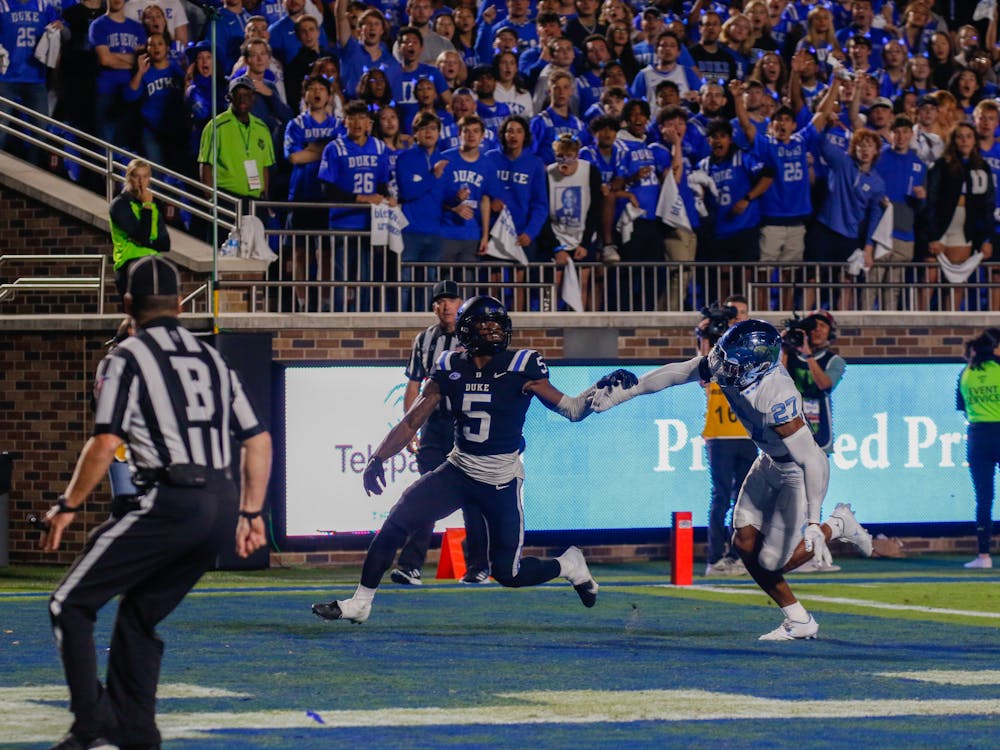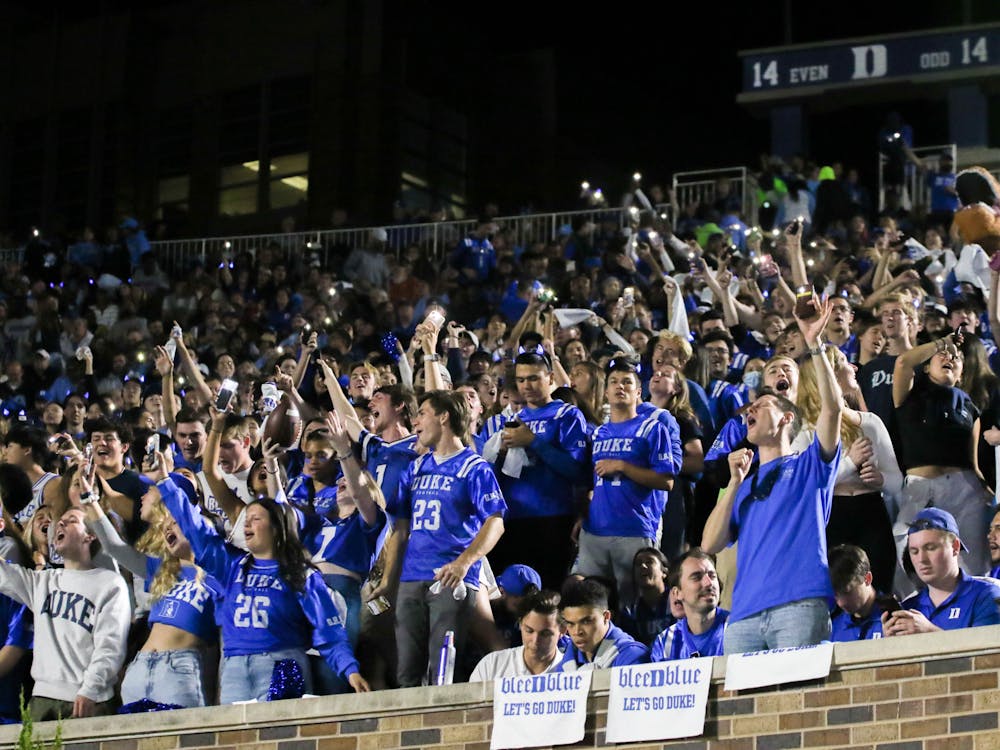Cheers, Miller Lite and body paint whipped out of a large reserved section behind the visitor bench at Wallace Wade Stadium like the solar flares of a feisty young star. Sunset had long since come and gone, with the stadium’s floodlights the only thing illuminating a sea of personalized Duke blue jerseys.
It was Oct. 15, the night of the Duke-North Carolina football game, and as the game reached a fever pitch, so too did the student section. On and off the field, something special was brewing.
“It was awesome,” Zach Calpey, a freshman who has attended most home games this season, said. “The atmosphere was crazy. Every time they scored we went crazy. And just like the whole student section was very hype, very loud, very excited.”
The coolest thing?
“Everyone stayed from the first quarter all the way to the last minute of that fourth quarter,” Amber Smith, a junior who hasn’t missed a home game in the past two seasons, said.
For Duke students, after years of being known for coming to football games in small numbers and leaving at halftime, that was special. What it signaled was even more so: the full-force return of football culture to campus for the first time in any current student’s memory.
In a story about passionate students, a tireless marketing department and a zealous head coach, here’s how it happened.
40,004 people
Wallace Wade’s second standing-room-only crowd since 2016 renovations was treated to a 38-35 heartbreak against the Tar Heels. Still, it was the climax of a story that had been building since Dec. 13, 2021.
Before that date, it seemed impossible that Duke could field an exciting, competitive team just months after going 3-8 overall and 0-9 in the ACC. Equally, though, it seemed impossible that a huge contingent of students enamored with football would be there to support them.
But on Dec. 13, 2021, Mike Elko, announced as head coach three days prior, stood at a podium at Pascal Field House to address the Blue Devil faithful for the first time and said, “Now is the time for Duke football.”
He didn’t just mean that they would win now, though they did. The Blue Devils went 8-4 in 2022, securing their first bowl game in four years and joining the likes of Clemson, North Carolina, Florida State and Pittsburgh as the only ACC teams with winning conference records.
His message was clear. It was time for everyone—Durhamites, students, alumni, everyone—to buy in and show up on fall Saturdays to support the team.
“We have to make people understand that they can control where this program goes, sometimes as much as we can,” Elko said. “We can't become a great football program without fan support. We can't become everything that we are capable of being as a program without people coming out and supporting our team.”

9,000 more
Did they get the message?
Resoundingly, yes.
Just greater than 9,000 more people on average attended Duke home games this season compared to last, with average attendance leaping to 24,505 from 15,424. This represented the second-highest year-over-year percent increase in average attendance in the Power 5 and the fourth-highest in the nation.
However, as much as it may seem like Duke was magically blessed with good football and game-day culture, the truth is actually much more complicated—and much more fascinating.
Get The Chronicle straight to your inbox
Sign up for our weekly newsletter. Cancel at any time.
Chris Alston has worked in the marketing department of Duke athletics since 2014 and currently serves as Executive Director of Marketing, a position he has held since 2019. Alston oversees all marketing efforts for Duke football, which, in collaboration with teams of people across campus, have been in hyperdrive for the past year.
He said the first step came in early 2022, shortly after Elko arrived on campus.
“Getting our students engaged was something that was a top priority of his from day one,” Alston said. “And we sat down with him once he got here and we outlined a plan … for getting his vision out there for how he wanted to promote the program.”
Alston noted that there were “a lot of” meetings between his team and Elko, but one of the first agenda items was moving the student section. Previously, students sat in the concrete bleachers behind the northern end zone, but Elko proposed that the student section be moved to a swath of reserved seats along the visitor bench.
The move was simple but effective. Sections 8, 9, 10 and 11 in Wallace Wade, the official designations of the student section, are adjacent to the mouth of the tunnel from which the Blue Devils come and go. After many games this season, a portion of students has stayed behind for a postgame speech from Elko and high-fives from players.
Being behind the visitor’s bench has allowed a time-honored tradition: heckling. Calpey and his friends arrived at every game early to watch—and jeer—from the front row.
“We were front row … and talked a lot of trash to the UNC players, which was very fun,” Calpey said.
‘3 hours before’
To encourage students to come in the first place, the marketing team had a few tricks up its sleeve. First, there were cash prizes given out by the Blue Devil at the end of each quarter. The biggest step, though, was the creation of DevilsGate, a tailgate introduced this season that takes over Card Lot, Krzyzewskiville and really anywhere near Wallace Wade that can fit a tent and a cooler.
The DevilsGate initiative has actually been in development since before the Elko era. The marketing department worked with the Fuqua Client Consulting Practicum on a semester-long study to figure out how to drive engagement with the team.
What they found was that Duke needed better tailgating.
After learning what a first down was on the bus ride from East Campus to Wallace Wade, Smith, who is dating senior tight end Mason Russell, showed up to her first-ever football game in 2019 just a few minutes before kickoff. While you could find small, independent tailgates in the corners of the Blue Zone parking lot back then, it wasn’t widespread and a small percentage of fans attended.
“There was not much of a tailgating community before,” Smith said. “ I remember coming in and running into the stadium.”
DevilsGate, made possible through the collaborative effort of many campus groups, has changed that. Marketing worked with Duke University Union to put on a concert for the first game of the year, and has reached out to Greek life representatives and other student groups to encourage them to sign up for tents, all in an effort to create a “festival-type atmosphere.”
The result, now, is that game day starts early.
“To me, I don't think of game time as kickoff. I think of game time as literally three hours before, because that's when I'm heading over to Card Lot,” Smith said. “I really do think that tailgating has the potential even to grow and continue to help flourish the culture and get people to the games.”
While the other home games had a good-sized chunk of people show out, for the North Carolina game, Smith and other Duke fans got a taste of what it was like to be a truly rambunctious football school. Before the game, every free space surrounding the athletics complex was swarmed with students, alumni and fans. There was hardly enough room to think, let alone move, between all the people, bouncy castles and food trucks.
“We had, I mean, thousands of students out there beforehand. We brought the big screen out, and people were out there all day watching games and just tailgating and having a great time,” Alston said.
Calpey was one of them. He said that while he and his friends usually hurry into the stadium to get front-row seats, they hung out for a while before the North Carolina game and watched Tennessee upset Alabama on the big screen in K-Ville to get pumped for the game.
“We just need to start treating every day like it's UNC,” he said.

7,500 jerseys
One of the most unique things about Duke game days is that the vast majority of students in attendance wear personalized Duke blue jerseys that they got for free. Of all efforts to promote the team, this one was the biggest logistical hurdle.
It started with just the freshmen, who each received a jersey with their last name and the number “26” representing their graduation year. Alston said that the marketing team partnered with the registrar’s office and first-year programs to reach out over the summer and gather names and sizes from the incoming class. Then came distributing the jerseys.
“This was another part of what we had to do: moving freshman orientation from East Campus and bringing that event to Brooks Field at Wallace Wade Stadium where we did the distribution during orientation week,” Alston said. “It allowed us to get the first-year students into the football stadium before the season so they could get a feel for what the stadium looked like and how to get in. And we distributed the jerseys and then did a big pep rally in Cameron.”
And that was that, or so they thought.
Feedback poured in “every way you can imagine,” according to Alston. The overwhelming consensus was that other students, graduate students included, wanted jerseys too. They let the team know on team social media, on Elko’s own social media and even walked up to athletics staff during games and tailgates early in the season to ask where to get one.
“I know [the jerseys] were a really big hit with the freshman class, and all my friends were like, ‘Oh no, why don't we get some?’, and they responded nicely and gave everyone else jerseys,” Smith said.
So, the marketing team got to work. It was all hands on deck to ensure students got their jerseys before the North Carolina game. In total, they made around 7,500 jerseys: 1,600 for the freshmen and about 6,000 for everyone else.
Synergy Imports, the company Duke partnered with to produce these jerseys, had to shut down production of anything else for two weeks and work 24 hours a day on the Duke jerseys in order to get them all made on time, according to Alston. While he couldn’t disclose the exact cost, the entire effort cut a “six-figure” chunk out of Duke’s athletics budget.
62.3 million views
It was worth it, though. The jerseys were a large part of promoting the team on campus, which has built hype for the team beyond. According to director of football digital strategy Brent Greenberg, who joined the staff in February 2022, Duke has added the most Instagram followers of any ACC team this season and is in the top 10 in the nation. It has also seen the largest follower growth (63%) from Aug. 1 to Dec. 1 of any team in the Power 5.
The team wanted to meet students where they were, and that was on social media, especially TikTok. Greenberg said that this season, the social media team wanted to make content beyond just hype videos. For TikTok, the players and staff were excited about making videos to reach fans, which led to a lot of content being player-driven, and so far, the account has amassed 62.3 million views. Meanwhile, the social media team gave jersey reveal videos extra oomph by taking inspiration from iconic bits of sports culture, like the “Mean” Joe Greene Coke commercial.
While the biggest factor has been the team’s on-field resurgence, all these efforts—tailgating, free jerseys, social media, etc.—have come at just the right time to help get Duke football on a national stage. In an increasingly turbulent college football world rife with conference realignment and skyrocketing TV contracts, programs that can’t figure out how to field good, exciting teams will get left behind.
For now, it seems like Duke has started to figure it out. While upperclassmen generally remain somewhat cynical about Blue Devil football, the younger grades are ready to show out in support of the team.
“I've heard from people in other grades like, ‘Oh, like they're trying so hard,’ but I think that's a good thing. In the freshman class, it's definitely exciting, and I think as we get new classes, and they get to experience the new wave of football … I think it'll keep growing,” Calpey said.
“I think we can definitely become a football and basketball school.”

Sasha Richie is a Trinity senior and a sports managing editor of The Chronicle's 118th volume.

